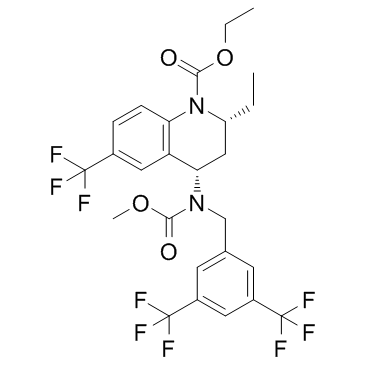Torcetrapib

Torcetrapib structure
|
Common Name | Torcetrapib | ||
|---|---|---|---|---|
| CAS Number | 262352-17-0 | Molecular Weight | 600.47 | |
| Density | 1.4±0.1 g/cm3 | Boiling Point | 504.8±50.0 °C at 760 mmHg | |
| Molecular Formula | C26H25F9N2O4 | Melting Point | 54-58ºC | |
| MSDS | Chinese USA | Flash Point | 259.1±30.1 °C | |
| Symbol |

GHS07 |
Signal Word | Warning | |
|
Cholesteryl ester-transfer protein inhibitors stimulate aldosterone biosynthesis in adipocytes through Nox-dependent processes.
J. Pharmacol. Exp. Ther. 353(1) , 27-34, (2015) Hyperaldosteronism and hypertension were unexpected side effects observed in trials of torcetrapib, a cholesteryl ester-transfer protein (CETP) inhibitor that increases high-density lipoprotein. Given that CETP inhibitors are lipid soluble, accumulate in adip... |
|
|
Effect on cardiovascular risk of high density lipoprotein targeted drug treatments niacin, fibrates, and CETP inhibitors: meta-analysis of randomised controlled trials including 117,411 patients.
BMJ 349 , g4379, (2014) To investigate the effects on cardiovascular outcomes of drug interventions that increase high density lipoprotein levels.Meta-analysis.Therapeutic benefit of niacin, fibrates, and cholesteryl ester transfer protein (CETP) inhibitors on cardiovascular events ... |
|
|
Identification of a novel, non-tetrahydroquinoline variant of the cholesteryl ester transfer protein (CETP) inhibitor torcetrapib, with improved aqueous solubility.
Xenobiotica 44(7) , 591-605, (2014) 1. Elaborate studies of cholesteryl ester transfer protein (CETP) polymorphisms and genetic deficiency in humans suggest direct links between CETP, high-density lipoprotein cholesterol (HDL-c) levels and coronary heart diseases. The hypothesis that CETP inhib... |
|
|
Upregulating reverse cholesterol transport with cholesteryl ester transfer protein inhibition requires combination with the LDL-lowering drug berberine in dyslipidemic hamsters.
Arterioscler. Thromb. Vasc. Biol. 33(1) , 13-23, (2013) This study aimed to investigate whether cholesteryl ester transfer protein inhibition promotes in vivo reverse cholesterol transport in dyslipidemic hamsters.In vivo reverse cholesterol transport was measured after an intravenous injection of (3)H-cholesteryl... |
|
|
Effect of dalcetrapib, a CETP modulator, on non-cholesterol sterol markers of cholesterol homeostasis in healthy subjects
Atherosclerosis 219(2) , 761-7, (2011) Objective Subjects with high HDL-C show elevated plasma markers of cholesterol absorption and reduced markers of cholesterol synthesis. We evaluated the effect of dalcetrapib, a cholesteryl ester transfer protein modulator, on markers of cholesterol homeostas... |
|
|
Implications of torcetrapib failure for the future of HDL therapy: is HDL-cholesterol the right target?
Expert Rev. Cardiovasc. Ther. 8(3) , 345-58, (2010) Owing to many potentially anti-atherogenic functions and the inverse correlation of high-density lipoprotein (HDL)-cholesterol (C) plasma levels with cardiovascular risk, HDLs have evolved as an attractive target for the prevention and therapy of coronary hea... |
|
|
New approaches to atherosclerotic cardiovascular disease. the potentialities of torcetrapib.
Recent Pat. Cardiovasc. Drug Discov. 1(1) , 109-14, (2006) Atherosclerosis is the leading cause of death and disability in the developed world. Although the low-density lipoprotein (LDL) cholesterol lowering drugs reduce the mortality and morbidity associated with coronary artery disease, considerable mortality and m... |
|
|
Will torcetrapib be the next big thing in coronary heart disease risk reduction?
Curr. Atheroscler. Rep. 9(1) , 48-56, (2007) Scientists are seeking ways to increase high-density lipoprotein (HDL) cholesterol to lower coronary heart disease (CHD). Emerging from this search is torcetrapib, a partial inhibitor of cholesteryl ester transfer protein. Via this mechanism, cholesteryl este... |
|
|
Torcetrapib/atorvastatin combination therapy.
Expert Rev. Cardiovasc. Ther. 3(5) , 789-820, (2005) Elevated blood levels of low-density lipoprotein cholesterol (LDL-C) are associated with an increased risk for atherosclerotic coronary heart disease (CHD). Atorvastatin is a statin drug that inhibits 3-hydroxy-3-methyl-glutaryl coenzyme A reductase (the rate... |
|
|
JTT-705: is there still future for a CETP inhibitor after torcetrapib?
Expert Opin. Investig. Drugs 17(10) , 1589-97, (2008) Despite reduction in low-density lipoprotein cholesterol, there is still a considerable amount of residual atherosclerosis-related disease. Epidemiological and pathophysiological data strongly favour increasing plasma high-density lipoprotein (HDL) cholestero... |